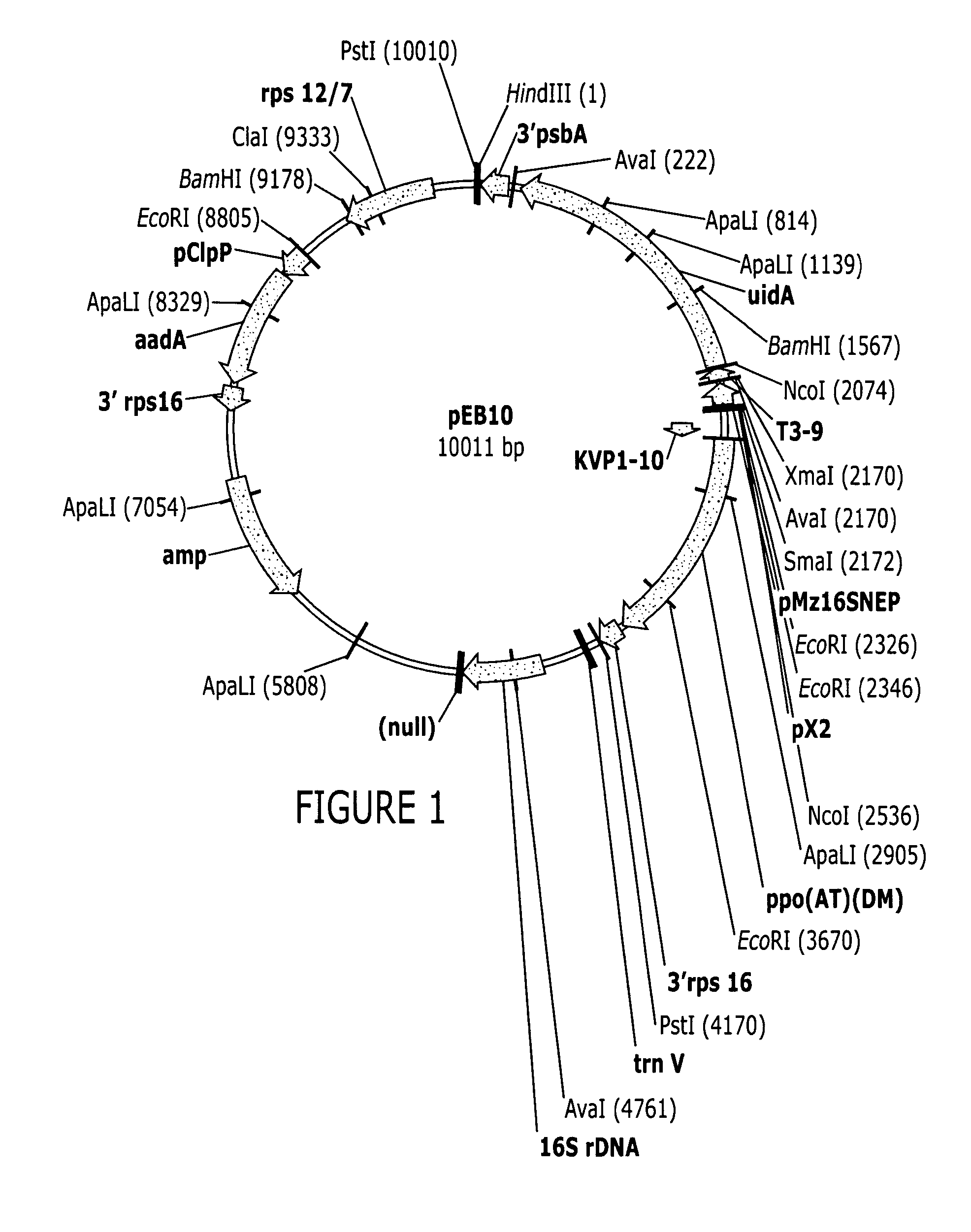Promoters functional in plant plastids
a technology of plant plastids and promoters, which is applied in the field of gene promoter nucleic acid sequences, can solve the problems of loss or inactivation of transgenic function, and achieve the effect of continuing normal growth or function
- Summary
- Abstract
- Description
- Claims
- Application Information
AI Technical Summary
Benefits of technology
Problems solved by technology
Method used
Image
Examples
example 1
Making of Plastid Transformation Vector Having PPO has Selectable Marker which is Under the Control of the Bacteriophage X2 Promoter
[0056]Amplification of the Bacteriophage kvp1 Gene 10 5′ UTR
[0057]The kvp1 gene 10 5′ UTR was isolated by PCR amplification from a plasmid containing kvp1 gene 10 using a top strand primer comprising an introduced XbaI restriction site at the 5′ end of the 5′ UTR region (5′ GTTCTAGAGACATTACGTTCTCCCCTTG3′ (SEQ ID NO:5) (XbaI site is underlined) and a bottom strand primer comprising an introduced NcoI restriction site overlapping the ATG initiation codon (5′ AGATATCCATGGTGAATCTCCTGTTGATT3′ (SEQ ID NO:6) (NcoI restriction site is underlined)). PCR amplification of a 119 bp fragment was performed with taq DNA Polymerase kit (QIAGEN, Valencia, Calif.) in a Perkin Elmer Thermal Cycler 480 according to the manufacturer's recommendations (Perkin Elmer / Roche, Branchburg. N.J.) as follows 5 min 95° C., followed by 5 cycles of 1 min 95° C. / 1 min 40° C. / 15 sec 72° ...
example 2
Construction of Plasmid RTK7
[0061]The 116 bp bacteriophage T3 gene 5′ UTR was PCR amplified from a plasmid using a top strand primer (RTK36) comprising an introduced NcoI restriction site at the 3′ end of the T3 gene 9 5′ UTR (5′ GAAGATGCCATGGATTAAATCTCCTAAGTTATTAAAG 3′ (SEQ ID NO:9) (NcoI site is underlined)) and a bottom strand primer (RTK39) comprising an introduced SmaI site at the 5′ end of the 5′ UTR (5′ CGAATCTCTTCCCGGGTAGAGGGAGACCTCATCTTTG 3′ (SEQ ID NO:10) (SmaI restriction site is underlined)). A 328 bp fragment having the Maize 16S PEP-NEP rRNA gene promoter and tobacco psbA gene promoter was PCR amplified from pEBT3–9 GFP using a top strand primer (RTK38) comprising an introduced SmaI restriction site at the 3′ end of the Maize 16S PEP-NEP promoter (5′ CTCCCTCTACCCGGGAAGAGATTCGGAATTGTCTTTCC 3′ (SEQ ID NO:11) (SmaI site is underlined)) and a bottom strand primer (RTK37) comprising an introduced BspHI site at the 3′ end of the psbA 5′ UTR (5′ CGCTTAGTCATGATAAAATCTTGGTTTATT...
example 3
Construction of a Bacteriophage X2 Promoter-Like Sequence Fused to the kvp1 Gene 10 5′ UTR: GFP::A. thaliana Plastid psbA 3′ UTR Chimeric Gene
[0063]An 85 bp EcoRI-XbaI fragment consisting of the bacteriophage X2 promoter-like sequence was created by annealing together a top stand oligonucleotide (5′ AATTCGTTAAAGAATGTAGCTGACTGCATACTTAAACCACCCATACTAGTTGCTG GGTGGTTTTTATGTTATAATATAAATGTGT 3′) (SEQ ID NO:13) with the following complimentary bottom strand oligonucleotide (5′ CTAGACACATTTATATTATAACATAAAAACCACCCAGCAACTAGTATGGGTGGTT TAAGTATGCAGTCAGCTACATTCTTTAACG 3′) (SEQ ID NO:14). Plasmid PEBX2 was created by ligating the created 85 bp EcoRI-XbaI fragment with a 6.8 kb EcoRI-XbaI fragment from pEBZM16SKGFP plasmid, containing the kvp1 gene 10 5′ UTR::GFP::A. thaliana psbA 3′ UTR with the remainder of the plastid transformation vector. The nucleotide sequence of the chimeric Staphylococcus aureaus bacteriophage X2 promoter like-sequence fused to the bacteriophage kvp1 gene 10 5′ UTR is in S...
PUM
| Property | Measurement | Unit |
|---|---|---|
| pH | aaaaa | aaaaa |
| pH | aaaaa | aaaaa |
| molar ratio | aaaaa | aaaaa |
Abstract
Description
Claims
Application Information
 Login to View More
Login to View More - R&D
- Intellectual Property
- Life Sciences
- Materials
- Tech Scout
- Unparalleled Data Quality
- Higher Quality Content
- 60% Fewer Hallucinations
Browse by: Latest US Patents, China's latest patents, Technical Efficacy Thesaurus, Application Domain, Technology Topic, Popular Technical Reports.
© 2025 PatSnap. All rights reserved.Legal|Privacy policy|Modern Slavery Act Transparency Statement|Sitemap|About US| Contact US: help@patsnap.com

